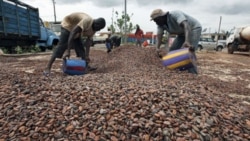This is the VOA Special English Agriculture Report.
Valentine's Day, February fourteenth, is one of the biggest days of the year for lovers of chocolate. Americans are expected to spend more than one billion dollars on chocolates and other candies for their sweethearts this holiday.
But the chocolate industry worries that prices for its sweets could rise in the years ahead. Susan Smith is a spokeswoman for the National Confectioners Association, a trade group for the candy, chocolate and gum industries.
SUSAN SMITH: "They're very aware that an everyday candy product needs to be an affordable treat."
Americans buy more than eighteen billion dollars worth of chocolate each year. But keeping chocolate at prices that people can afford may be a challenge in the future.
Demand is growing, especially in Asia. More people in Asia are developing a taste for chocolate and have more money to buy it. The chocolate industry worries that supply will not keep up with demand.
Cocoa is the main ingredient in chocolate. Millions of poor farmers in West Africa grow about seventy percent of the world's cocoa. Each farmer has just a few hectares of land.
LYNDEL MEINHARDT: "And they don't have a lot of additional capital. They may not have the management skills that are required to actually do a better job."
Lyndel Meinhardt supervises cocoa research at the United States Department of Agriculture. Mr. Meinhardt says these farmers often do not have the money to buy fertilizers that would increase their productivity.
And Sona Ebai with the World Cocoa Foundation says when the land stops producing, farmers just clear more land. Deforestation in West Africa is largely the result of so-called slash-and-burn agriculture for cocoa and other crops.
Mr. Ebai, a senior technical adviser, says economic forces are not the only problems facing cocoa farmers. Experts say pests and diseases destroy thirty to forty percent of the world's cocoa crop each year.
The chocolate industry needs farmers to produce more cocoa to meet the growing demand. Small-scale farmers need help to increase their productivity and lift themselves out of poverty, without destroying more rainforest. And West African governments want to help an industry worth eight billion dollars a year. Sona Ebai says all sides are working together to seek solutions.
SONA EBAI: "For the first time, farmers, processors, chocolate multinationals, civil society are working to make sure that the cocoa economy in the world is sustainable -- everybody chipping in to make it stay that way."
Millions of dollars are being invested to increase the productivity of West African cocoa farmers. Chocolate makers like Mars and Nestle are putting money into the effort. So are organizations like the United States Agency for International Development and the Bill and Melinda Gates Foundation.
And that's the VOA Special English Agriculture Report. I'm Jim Tedder.
___
Contributing: Steve Baragona




